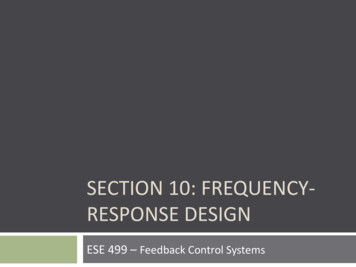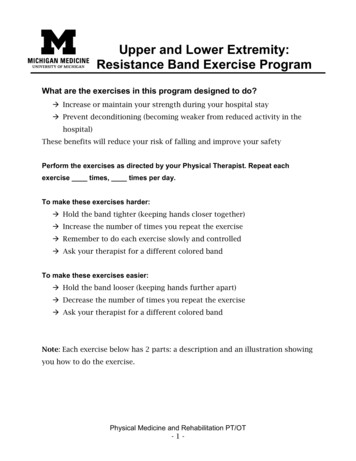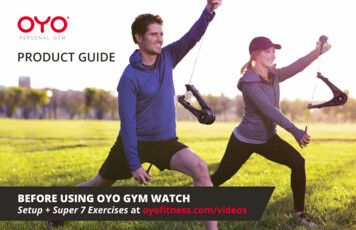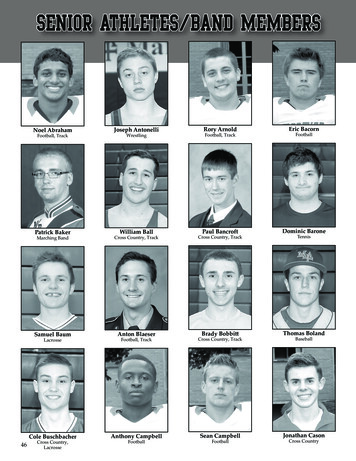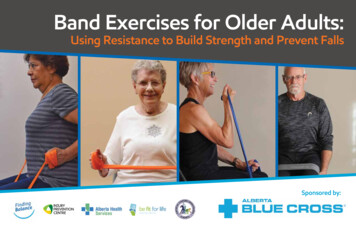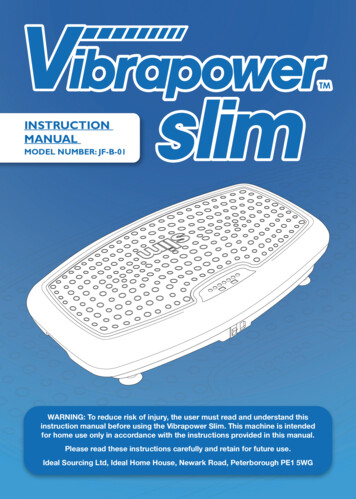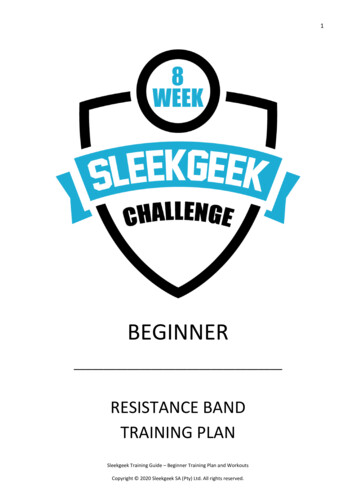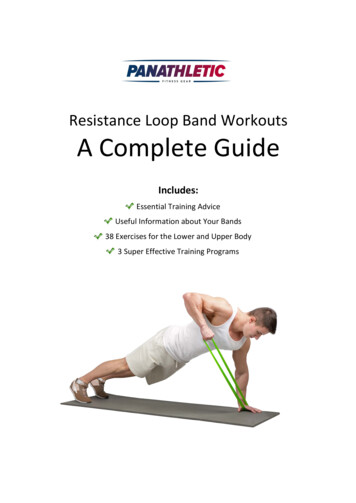
Transcription
Resistance Loop Band WorkoutsA Complete GuideIncludes:Essential Training AdviceUseful Information about Your Bands38 Exercises for the Lower and Upper Body3 Super Effective Training Programs
Copyright 2017 PanathleticAll Rights Reserved. Panathletic reserves the sole right to reproduce, distribute, or transmitthis book. Reproduction of any type, including photocopying, recording or any othermechanical or electronic method, without the express written permission from Panathletic,is prohibited. This product is not for resale. All images and graphics are owned byPanathletic and cannot be copied, reprinted, or reused without permission fromPanathletic.DisclaimerExercise at your own risk and on the basis of common sense. Take all necessary precautions.Check the bands before use to make sure they are in sound condition. In case you havedoubts about your physical condition, it is recommended that you consult with a localhealthcare practitioner before starting this exercise program. Panathletic disclaims liabilityfor any adverse loss, injury, or damage suffered by any person as a result of the use ormisuse of the Panathletic Resistance Loop Bands or due to any information included in thisbook.1
Table of ContentsPart I: Introduction and Information4Introduction4The Advantages of Resistance Loop Bands5Specifications of the Panathletic Resistance Bands6General Guidelines7Part II: Exercises for the Lower Body81. Lying Leg Abductions82. Inner Thigh Leg Lifts93. Lying Leg Raises104. Leg Curls115. Squats126. Bridges137. Monster Walk148. Donkey Kicks159. Knee Extensions1610. High Knees1711. Curtsy Lunges1812. Side Lunges1913. Resisted Plantarflexion2014. Clamshells21Part III: Exercises for the Upper Body2215. Arm Abductions2216. Biceps Curls2317. Triceps Extensions2418. Arm Abductions behind the Back2519. Overhead Press262
20. Seated Rows2721. External Rotations2822. Shoulder Extensions2923. Arm Raises3024. Horizontal Abductions3125. Internal Rotations3226. Forward Punches3327. Push Ups3428. Lat Pull Downs35Part IV: Advanced Exercises for the Lower Body3629. Squats and Kick3630. One-Legged Squats with Kick3731. One-Legged Bridges3832. Plank with Leg Extensions3933. Plank with Side Steps40Part V: Advanced Exercises for the Upper Body4134. Plank with Arm Raises4135. Push Ups with Arm Raises4236. Full Renegade Rows4337. Forward Bear Crawl4438. Sideways Bear Crawl45Part VI: Training Programs46Beginner Training Program46Advanced Training Program50Bonus: Booty Boost Program53Final Word573
Part I: Introduction and InformationPart I: Introduction and InformationIntroductionExercise is scientifically proven to have various benefits on our overall health and wellbeing. Regular physical activity can: reduce the risk of heart disease help control and maintain a healthy bodyweight reduce the risk of diabetes improve lung function strengthen bones and muscles supportingjoints improve mood and mental well-being.Most national health departments recommend 150 minutes of moderate to vigorousaerobic activity every week, combined with at least two days of strength training.Strength training refers to a type of exercise where resistance, such as in the form of aresistance loop band, is used to produce a muscle contraction. Repeated musclecontractions build anaerobic endurance and muscle size, contributing to increased muscularstrength.4
Part I: Introduction and InformationThe Advantages of Resistance Loop BandsThe Panathletic Resistance Loop Bands provide a cost-effective, convenient, and easy way towork out anytime, anywhere. No gym membership is required. They are lightweight and areeasy to pack for travel. Further, unlike weights or dumbbells, resistance bands offer amovement across a variety of planes and through all ranges of motion.The loop band is suitable for all levels offitness from those just looking to get backinto shape to those individuals who arelooking to advance their fitness to the nextlevel. Often in rehabilitation settings, loopresistance bands are used to perform basicexercises to help achieve and regain fullfunction following injury. The variety instrength levels provides options for all.The loop resistance bands aid in botheccentric and concentric contractions.Concentric contractions are when themuscle shortens. For example, in ourrowing exercise this would be happeningwhen pulling the band toward your chest.Eccentric contractions occur when themuscle lengthens. This type of contractionwould be the slow and controlledmovement of straightening the arms backto the start position for the seated row. Byfocusing on both types of contraction,more strength can be gained through eachand every exercise.This eBook, provided with your Panathletic Resistance Band Set, offers a variety of exercises,including 6-week training guides for beginners and advanced groups, with a bonus BootyBoost Program for the legs and butt. There are descriptions and images for each exercise.Make sure to follow the directions and to read our General Guidelines before starting anyexercise.5
Part I: Introduction and InformationSpecifications of the Panathletic Resistance BandsThe Panathletic bands offer a smooth, irritant-free surface preventing any burning on directband-to-skin contact. The bands measure 2 x 12 inches and are extremely durable. Includedin each Panathletic Resistance Band package are 4 or 5 resistance bands, listed as followsaccording to their resistance level. Only the 5-band set includes the XX Heavy band for extraintensive exercise.Band ColorResistanceLevelin Lbin KgLight2 - 4 lb1 - 2 kgMedium6 - 8 lb3 - 4 kgHeavy10 - 13 lb5 - 6 kgRedX Heavy15 - 20 lb7 - 9 kgBlackXX Heavy25 - 30 lb11 - 14 kgGreenBlueYellow6
Part I: Introduction and InformationGeneral GuidelinesIt is recommended to warm up before your fitness band workout. Properly warming up themuscles first can prevent the risk of injury. Take 5 to 10 minutes to run (on the spot, if thereis not enough space), jump rope, or walk at a high pace, or first carry out the exerciseswithout the bands.Always put the band flat on the arm orleg, so that the pressure of the band isdistributed equally over the skin.Use a yoga or training mat for exerciseswhich require you to lie down.It is important to carry out both thefirst movement and the movementback to the start position (whichrelaxes the band again) in a controlledmanner. Doing so will make each andevery exercise that much moreeffective.We recommend following one of theexercise programs at the end of thisbook. However, if you prefer following your own routine, we suggest, especially forbeginners, to first do a set of 15 reps of the exercise, then another 10 reps, and finally 5reps, as you will gradually exhaust your muscles.Take a 30-second break between sets.Swap sides and repeat the sets.Take a lighter loop band if you are not able to carry out 15 reps during the first set. If 15 repsare easy, then switch to a heavier band. Or extend the first set to a full 20, the second to 15,and the third to 10 reps.Advanced athletes can combine the heaviest band with a second band to create even moreresistance. The second band is placed under, next to, or over the first band.Always include a cool-down at the end of each workout. Static stretches following anexercise session can help prevent muscle soreness.7
Part II: Exercises for the Lower BodyPart II: Exercises for the Lower Body1. Lying Leg AbductionsYou will train: the glutes.1. Place the band around the ankles. Lie down with your legs almostcompletely stretched.2. Move your upper leg upward until the band attains about twice its normallength. Then move the leg back toward the start position without dropping itentirely.8
Part II: Exercises for the Lower Body2. Inner Thigh Leg LiftsYou will train: the inner thigh muscles (adductors).1. Take the following position: Lie down and bend your upper leg so that yourfoot rests flat on the mat. The lower leg is stretched and points with the innerside upward. Place the band under the foot of the upper leg and around theshin of the lower leg.2. Lift the lower leg straight upward and slowly bring it back down until it’s justabove the mat.9
Part II: Exercises for the Lower Body3. Lying Leg RaisesYou will train: the quadriceps and the hip flexors (iliopsoas).1. Place the band around the ankles, lie down on your back, and stretch yourlegs out in front.2. Keeping the left leg on the mat, lift the right leg straight (swap sides later).Slowly lower the right leg until it is just above the mat.10
Part II: Exercises for the Lower Body4. Leg CurlsYou will train: the hamstrings and the calves (gastrocnemius and soleus).1. This exercise is carried out from a standing position. Put the band aroundyour ankles.2. Curl your leg backward and upward. Make sure that the thigh of theexercising leg remains parallel to the leg on which you stand. Slowly lower theleg back down, just touching the toes to the ground.11
Part II: Exercises for the Lower Body5. SquatsYou will train: the glutes, core, and quadriceps.1. This exercise is carried out from a standing position. Place the band aroundyour lower thighs, just above your knees, and position your feet wide enoughso that there is tension in the band.2. Slowly squat down until your thighs are parallel with the ground. Make sureyour knees do not track over your toes. In a slow and controlled movement,push back up through your heels to the start position. You can intensify thisexercise by stepping one foot to the side while lowering your position. If youchoose to do this, don’t forget to swap sides.12
Part II: Exercises for the Lower Body6. BridgesYou will train: the glutes and the outer thigh muscles (abductors).1. Lie face up on the ground with your knees bent and your feet flat on theground. Place the band around your thighs, just above your knees. Positionyour feet wide enough so that there is slight tension in the band.2. In a slow and controlled movement, lift your hips up off the ground. Gentlypush your thighs out against the resistance of the band. Hold for 3-5 secondsand slowly lower back down to the start position.13
Part II: Exercises for the Lower Body7. Monster WalkYou will train: the glutes and the outer thigh muscles (abductors).1. This exercise is carried out from a standing position. Place the band aroundyour lower shins and position your feet approximately hip-width apart, with aslight bend in your knees.2. Walk one foot forward and out against the resistance of the band. Walk youropposite foot forward and out. Continue alternating sides. After 10 steps,repeat a similar pattern walking backwards to the start position.14
Part II: Exercises for the Lower Body8. Donkey KicksYou will train: the glutes.1. This exercise is carried out on all fours. Position your hands on the grounddirectly below your shoulders, and your knees on the ground directly belowyour hips. Place the band around your thighs, just above your knees.2. Keeping your knee bent at 90 degrees, kick one leg back until your thigh isparallel with the ground. Slowly lower and return to the start position. Repeatfor the opposite side.15
Part II: Exercises for the Lower Body9. Knee ExtensionsYou will train: the quadriceps.1. This exercise is carried out from a sitting position. Sit on a chair or bench.Place the band around the left ankle and secure the other part of the band onthe leg of the chair (swap sides later).2. Slowly extend the left leg straight out in front against the resistance of theband. Do not lock the knee at end range. Slowly return to the start position.16
Part II: Exercises for the Lower Body10. High KneesYou will train: the upper thighs (hip flexors and iliopsoas).1. This exercise is carried out from a standing position. Position your feet hipwidth apart and place the band around the arch of each foot.2. Maintain a straight back throughout the exercise. Bend the left knee up infront. Your thigh should come up high enough so that it is parallel to theground. In a slow and controlled movement, lower the leg. Alternate sides.17
Part II: Exercises for the Lower Body11. Curtsy LungesYou will train: the glutes, the inner thigh muscles (adductors), and the outerthigh muscles (abductors).1. This exercise is carried out from a standing position. Place the band aroundyour lower thighs, just above the knees.2. Step the left leg back and to the right (swap sides later). Lower into a lungeposition by bending both knees. Bend the knees until the front thigh is parallelto the ground. Push back up through the front heel to the start position.18
Part II: Exercises for the Lower Body12. Side LungesYou will train: the glutes, the inner thigh muscles (adductors), the outer thighmuscles (abductors), and the quadriceps.1. This exercise is carried out from a standing position. Place the band aroundyour ankles. Position your feet hip-width apart and your hands on your hips.2. Step your right foot out to the side and bend your left knee (swap sideslater). Keep your right leg straight. Slowly return to the start position.19
Part II: Exercises for the Lower Body13. Resisted PlantarflexionYou will train: the calf muscles (gastrocnemius and soleus).1. This exercise is carried out from a long-sitting position. Sit on the groundwith your left knee bent and your foot flat on the floor. Your right leg isstretched out straight in front. Place the band under the toes of the right foot(swap sides later). Hold the other end of the band with both hands close toyour abdominals.2. Slowly point the toes away from your body. Slowly return to the startposition.20
Part II: Exercises for the Lower Body14. ClamshellsYou will train: the outer thigh muscles (abductors) and glutes.1. This exercise is carried out from a side-lying position. Place the band aroundyour lower thighs, just above your knees. Lie on your side with both knees bentto 90 degrees.2. Do not rotate the trunk with the movement of this exercise. In a slow andcontrolled movement, lift your knee up as far as you comfortably can. Lowerthe knee back to the start position.21
Part III: Exercises for the Upper BodyPart III: Exercises for the Upper Body15. Arm AbductionsYou will train: the deltoid muscles, the pectoralis major, and the upper backmuscles (trapezius, infraspinatus, and teres major and minor).1. This exercise is carried out from a standing position. Place the band aroundyour wrists. Hold your fists in front of your waist. Bend your arms only slightly.2. Spread your arms until the band has reached about twice its normal length.Then, slowly move your arms back until there is only a slight tension on theband.22
Part III: Exercises for the Upper Body16. Biceps CurlsYou will train: the biceps.1. Sit down on an exercise bench or on the edge of a chair. Place the bandaround the left leg, just above the knee (swap sides later). Lower this leg inorder to create space for the exercise. Take the band in your left hand.2. Curl your exercising arm until your hand is close to your chin. Move the armback toward the knee until there is only a slight tension on the band.23
Part III: Exercises for the Upper Body17. Triceps ExtensionsYou will train: the triceps.1. The exercise is carried out from a standing position. Place the band aroundthe left hand and place this hand on your right breast (swap sides later). Placeyour right hand in the loop.2. Stretch your right arm until your hand is close to your hip. Slowly move yourhand back toward the start position until there is only a slight tension on theband.24
Part III: Exercises for the Upper Body18. Arm Abductions behind the BackYou will train: the deltoid muscles, the triceps, and the upper back muscles(trapezius, infraspinatus, and teres major and minor).1. The exercise is carried out from a standing position. Put your arms behindyour back. Place the band around your wrists and straighten your arms.2. Spread your arms until the band reaches about twice its normal length.Slowly move your arms back toward the start position until there is only aslight tension on the band.25
Part III: Exercises for the Upper Body19. Overhead PressYou will train: the deltoid muscles, triceps, biceps, and the upper back muscles(trapezius).1. This exercise is carried out while standing. Wrap your left hand in the bandand place this hand just above your right shoulder (swap sides later). Wrapyour right hand through the band at the lower end.2. Slowly raise your right hand straight up above your head. Slowly lower yourarm back down to the start position.26
Part III: Exercises for the Upper Body20. Seated RowsYou will train: the deltoid muscles and the upper and middle back muscles(trapezius, teres major, rhomboids, and latissimus dorsi).1. This exercise is carried out from a long-sitting position. Sit with your legsstretched out straight in front. Place the band around both feet and hold theother end of the loop with both hands positioned shoulder-width apart. Yourarms should be only slightly bent to start.2. As you pull the band toward you, bend your elbows alongside your body.Pinch your shoulder blades down and in. Do not shrug your shoulders. In aslow and controlled movement, return to the start position.27
Part III: Exercises for the Upper Body21. External RotationsYou will train: the deltoid muscles, the upper back muscles (trapezius andrhomboids), and the posterior shoulder muscles (supraspinatus, infraspinatus,and teres minor).1. This exercise is carried out from a standing position. Place the band aroundyour wrists. Bend your elbows to 90 degrees.2. Keeping your elbows close to your body, spread your arms. As you spreadyour arms, pinch your shoulder blades down and in. Slowly return to the startposition.28
Part III: Exercises for the Upper Body22. Shoulder ExtensionsYou will train: the shoulder muscles (posterior deltoid muscles), the backmuscles (the latissimus dorsi, the infraspinatus, and the teres major), and thetriceps.1. This exercise is carried out from a standing position. Place the band aroundyour wrists. Position your left arm straight in front at plexus height, and yourright hand below with slight tension in the band (swap sides later).2. Keeping your arms straight, raise your left arm and lower your right armagainst the resistance of the band. In a slow and controlled movement, returnto the start position.29
Part III: Exercises for the Upper Body23. Arm RaisesYou will train: the anterior deltoid muscles, the pectoralis major, and thebiceps.1. This exercise is carried out from a standing position. Take the band in yourhands at both ends. Position your left arm relaxed beside your body. Positionyour right arm slightly higher than your left arm, with some tension in theband.2. Straighten your arms and raise your right arm straight up in front. In a slowand controlled movement, return to the start position.30
Part III: Exercises for the Upper Body24. Horizontal AbductionsYou will train: the posterior deltoid muscles and the upper back muscles(trapezius, infraspinatus, and teres minor).1. This exercise is carried out from a standing position. Place the band aroundyour wrists. Hold both arms straight in front at shoulder height.2. Slowly spread your arms until the band reaches up to twice its normallength. Move your arms back to the start position.31
Part III: Exercises for the Upper Body25. Internal RotationsYou will train: the deltoids, the pectoralis major, and upper and middle backmuscles (latissimus dorsi, subscapularis, and teres major).1. This exercise is carried out from a standing position. Attach one end of theloop band around a doorknob or have a friend hold it steady to your right side.Hold the other part of the loop band with your right hand (swap sides later).Keeping your upper arm close to the body, bend your elbow to 90 degrees.2. Continuing to keep the upper arm close to the right side of your body, slowlybring your right hand inward toward the left lower ribcage. In a slow andcontrolled movement, return the right arm back to the start position.32
Part III: Exercises for the Upper Body26. Forward PunchesYou will train: the anterior shoulder muscles (the serratus anterior muscles) andthe pectoralis muscles.1. This exercise is carried out from a standing position. Bend your elbows, andhold the band, with slight tension, in both hands in front of your chest.2. Keeping the opposite arm stationary, push one arm straight out in frontagainst the resistance of the band (swap sides later). In a slow and controlledmovement, move your arm back to the start position.33
Part III: Exercises for the Upper Body27. Push UpsYou will train: the pectoralis muscles, the deltoid muscles, and the triceps.1. This exercise is carried out from a plank position on your hands and toes.Place the band around your arms, just below your elbows. Position your handsslightly wider than shoulder-width apart. You have to test the right distancebetween your hands because the band might roll up during step 2 if you don’tget it right.2. Bend your elbows and lower your chest and chin to the floor. Push back upthrough your hands.34
Part III: Exercises for the Upper Body28. Lat Pull DownsYou will train: the latissimus dorsi muscles and the triceps.1. This exercise is carried out from a standing position. Take the band in yourhands at both ends. Position your arms straight above your head with slighttension in the band.2. Slowly bend one elbow down and out to the side, spreading your arms, andbring the band down to head height (swap sides later). In a slow and controlledmovement, move your arm back to the start position.35
Part IV: Advanced Exercises for the Lower BodyPart IV: Advanced Exercises for the Lower Body29. Squats and KickYou will train: the glutes, core, and quadriceps.1. This exercise is carried out from a standing position. Place the band aroundyour lower shins and position your feet wide enough so that there is slighttension in the band.2. Slowly squat down until your thighs are parallel with the ground. Make sureyour knees do not track over your toes. In a slow and controlled movement,push back up through your heels to the start position. At the same time, kickyour right leg out and back against the resistance of the band (swap sideslater). Return to the start position.36
Part IV: Advanced Exercises for the Lower Body30. One-Legged Squats with KickYou will train: the glutes, quadriceps, hamstrings, and the outer thigh muscles(abductors).1. This exercise is carried out from a standing position. Place the band aroundyour ankles or lower shins. Step your right foot back.2. Lift your right foot off the ground. Extend your arms straight out in front forbalance. Slowly bend your left knee and squat down until your left thigh isparallel with the ground. As you push through your left heel back up to start,kick the right leg straight back. Return to the start position.37
Part IV: Advanced Exercises for the Lower Body31. One-Legged BridgesYou will train: the glutes and the outer thigh muscles (abductors).1. Lie face up on the ground with your knees bent and your feet flat on theground. Place the band around your thighs, just above your knees. Positionyour feet wide enough so that there is slight tension in the band.2. In a slow and controlled movement, lift your hips up off the ground. Gentlypush your thighs out against the resistance of the band. In a slow andcontrolled movement, lift the left leg straight up (swap sides later). Slowlylower the left leg and lower back down to the start position.38
Part IV: Advanced Exercises for the Lower Body32. Plank with Leg ExtensionsYou will train: the glutes and the core.1. This exercise is carried out from a plank position on your hands and toes.Place the band around your ankles. Position your feet wide enough so thatthere is slight tension in the band.2. Keeping the hips and trunk stationary, lift your right leg straight up (swapsides later). Slowly lower your right leg and return to the start position.39
Part IV: Advanced Exercises for the Lower Body33. Plank with Side StepsYou will train: the core, the glutes, and the outer thigh muscles (abductors).1. This exercise is carried out from a plank position on your forearms and toes.Place the band around your ankles. Position your feet wide enough so thatthere is slight tension in the band.2. Keeping the hips and trunk stationary, step the left foot out to the sideagainst the resistance of the band (swap sides later). Move the left foot back tothe start.40
Part V: Advanced Exercises for the Upper BodyPart V: Advanced Exercises for the Upper Body34. Plank with Arm RaisesYou will train: the anterior deltoid muscles, the pectoralis major, the biceps,and the core.1. This exercise is carried out from a plank position on your hands and toes.Place the band around your wrists. Position your arms wide enough so thatthere is slight tension in the band.2. Keeping the hips and trunk stationary, raise the left arm straight in front(swap sides later). Slowly lower the arm back to the start position.41
Part V: Advanced Exercises for the Upper Body35. Push Ups with Arm RaisesYou will train: the pectoralis muscles, the deltoid muscles, the triceps, thebiceps, and the core.1. This exercise is carried out from a plank position on your hands and toes.Place the band around your wrists. Position your hands slightly wider thanshoulder-width apart.2. Bend your elbows and lower your chest and chin to the floor. Push back upthrough your hands. As you are pushing back up, lift one arm off the grounddiagonally. Return to the start position.42
Part V: Advanced Exercises for the Upper Body36. Full Renegade RowsYou will train: the deltoids, the biceps, upper and middle back muscles(trapezius, latissimus dorsi, teres major and minor, and rhomboids), and thecore.1. This exercise is carried out in a plank position on your hands and toes. Placethe band under your right hand and hold the other end of the loop band inyour left hand (swap sides later).2. Slowly bend your left elbow straight back. In a controlled movement, returnthe left arm back to the start position.43
Part V: Advanced Exercises for the Upper Body37. Forward Bear CrawlYou will train: the deltoid muscles, the pectoralis major, the biceps, and thecore.1. This exercise is carried out on all fours. Place the band around your wrists.Position your wrists wide enough so that there is slight tension in the band.Keeping your knees bent, lift them slightly off the ground.2. Walk one hand forward and the opposite foot forward. Walk the oppositehand forward with the opposite foot. Continue alternating sides. After 10steps, repeat a similar pattern walking backwards to the start position.44
Part V: Advanced Exercises for the Upper Body38. Sideways Bear CrawlYou will train: the deltoid muscles, the pectoralis major, the biceps, the core,and the upper back muscles (trapezius, infraspinatus, and teres minor).1. This exercise is carried out on all fours. Place the band around your wrists.Position your wrists wide enough so that there is slight tension in the band.Keeping your knees bent, lift them slightly off the ground.2. Walk your right hand and right foot to the right side. Walk the left hand andthe left foot to the right side. After 10 steps, repeat a similar pattern walking tothe left side back to the start position.45
Part VI: Training ProgramsPart VI: Training ProgramsRefer to our General Guidelines before starting the exercise programs involving the loop bands. A 510 minute warm-up is recommended before beginning your workout. A cooldown following yourworkout, involving stretching of the muscles used, is also recommended.In the training programs below you will find the number of recommended repetitions for eachexercise. If the exercise involves a right side and a left side, then carry out this number of repetitionson each side.Beginner Training ProgramOur 6-week Beginner Training Program using our Panathletic Resistance Loop Bands will set you upfor success, whether you are new to exercise or are just looking to get back into shape. The first 4weeks break the program up into arm and leg days to keep it simple and to ensure the muscles havetime to recover. After the first 4 weeks, we mix it up. New exercises targeting similar muscle groupsare added, and arm and leg days are combined. Each workout takes 20-30 minutes.If an exercise is too difficult, decrease the repetitions, sets, and/or resistance. If an exercise is tooeasy, increase the repetitions, sets, and/or resistance. Proper form is essential to ensure theexercises are effective and to avoid the risk of injury. Grab a friend or throw on your favorite music,and let’s get moving!Week #MondayTuesdayWednesdayThursdayFridayWeek 1Squats (5):10 repetitionsRESTRESTBiceps Curls (16):10 repetitionsRESTSide lunges (12):10 repetitionsTriceps Extensions (17):10 repetitionsLying LegAbductions (1):10 repetitionsArm Abductions (15):10 repetitionsOverhead Press (19):10 repetitionsLying Leg Raises (3):10 repetitionsSeated Rows (20):10 repetitionsLeg Curls (4):10 repetitionsRepeat twice.Repeat twice.46
Part VI: Training ProgramsWeek #MondayTuesdayWednesdayThursdayFridayWeek 2Squats (5):10 repetitionsRESTBiceps Curls (16):10 repetitionsRESTSquats (5):10 repetitionsSide Lunges (12):10 repetitionsTriceps Extensions (17):10 repetitionsSide Lunges (12):10 repetitionsLeg Curls (4):10 repetitionsHorizontal Abductions(24):10 repetitionsLying Leg Abductions(1):10 repetitionsOverhead Press (19):10 repetitionsLying Leg Raises (3):10 repetitionsExternal Rotations (21):10 repetitionsLeg Curls (4):10 repetitionsRepeat twice.Repeat twice.Bridges (6):10 repetitionsKnee Extensions (9):10 repetitionsRepeat twice.Week 3Biceps Curls (16):10 repetitionsRESTSquats (5):10 repetitionsRESTBiceps Curls (16):10 repetitionsTriceps Extensions (17):10 repetitionsSide Lunges
Advanced athletes can combine the heaviest band with a second band to create even more resistance. The second band is placed under, next to, or over the first band. Always include a cool-down at the end of each workout. Static stretches following an exercise session can help prevent muscle soreness.

